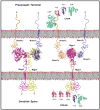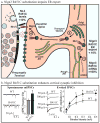Neuroligins and neurexins link synaptic function to cognitive disease
- PMID: 18923512
- PMCID: PMC2673233
- DOI: 10.1038/nature07456
Neuroligins and neurexins link synaptic function to cognitive disease
Abstract
The brain processes information by transmitting signals at synapses, which connect neurons into vast networks of communicating cells. In these networks, synapses not only transmit signals but also transform and refine them. Neurexins and neuroligins are synaptic cell-adhesion molecules that connect presynaptic and postsynaptic neurons at synapses, mediate signalling across the synapse, and shape the properties of neural networks by specifying synaptic functions. In humans, alterations in genes encoding neurexins or neuroligins have recently been implicated in autism and other cognitive diseases, linking synaptic cell adhesion to cognition and its disorders.
Figures





References
-
- Cowan WM, Südhof TC, Stevens CF, editors. Synapses. Johns Hopkins University Press; 2000.
-
- Rozov A, Burnashev N, Sakmann B, Neher E. Transmitter release modulation by intracellular Ca2+ buffers in facilitating and depressing nerve terminals of pyramidal cells in layer 2/3 of the rat neocortex indicates a target cell-specific difference in presynaptic calcium dynamics. J Physiol. 2001;531(Pt 3):807–826. - PMC - PubMed
-
- Dityatev A, El-Husseini A, editors. Molecular Mechanisms of synaptogenesis. Springer Verlag; New York: 2006.
-
- Abbott LF, Regehr WG. Synaptic computation. Nature. 2004;431:796–803. - PubMed
-
- Linkenhoker BA, von der Ohe CG, Knudsen EI. Anatomical traces of juvenile learning in the auditory system of adult barn owls. Nat Neurosci. 2005;8:93–98. - PubMed
Publication types
MeSH terms
Substances
Grants and funding
LinkOut - more resources
Full Text Sources
Other Literature Sources
Medical
Molecular Biology Databases

